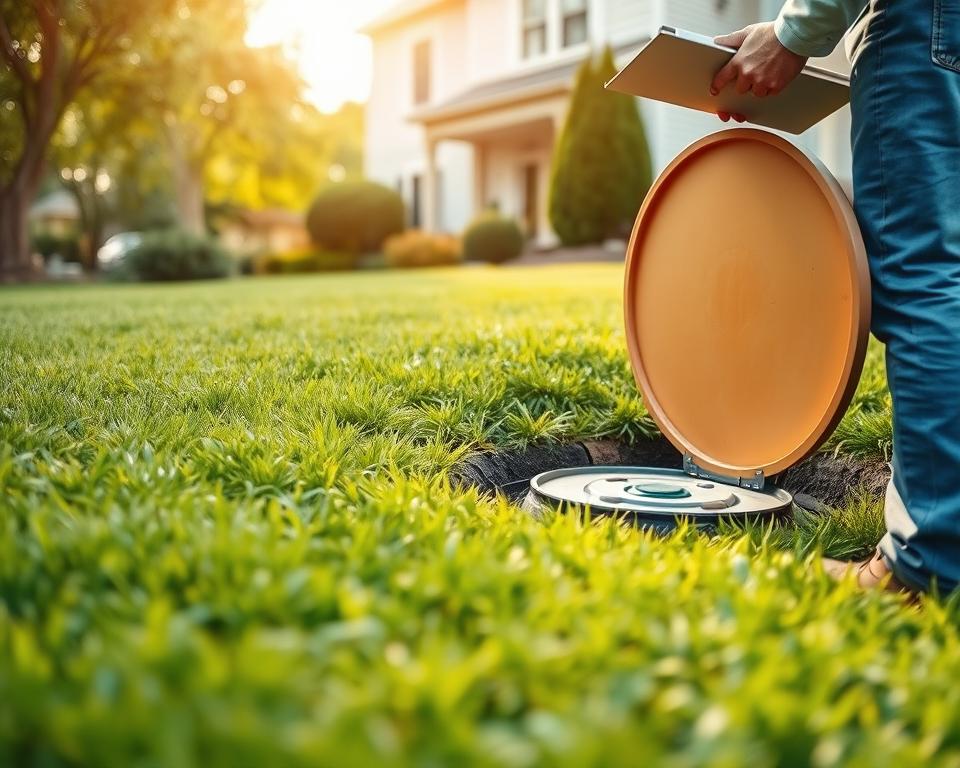Septic Air Pump: Essential Guide for Property Owners
Have you ever wondered what enhances your oxygen-based Septic system’s performance? The Septic air pump is the unrecognized key component crucial for your system. In this article, property owners will gain useful know-how on the Septic air pump’s function. It’s critical for a robust, efficient Septic system.
Knowing the importance of a Septic tank air Pump can optimize your Septic system’s operation using septic tank inspection. It also protects your home equity and ecological well-being. The following guide will feature All in Sanitation, a trusted Septic industry leader. They’re ready to serve your Septic aerator Pump needs.
Primary Highlights
- The Septic air Pump is vital for aerobic Septic systems.
- Maintaining your Septic system air Pump can improve overall system performance.
- Regular checks increase the service life of your Septic tank air Pump.
- Choosing the right Septic aerator Pump is necessary for peak operation.
- All in Sanitation delivers specialized services for Septic air Pump solutions.
Exploring Aerobic Septic Solutions
Aerobic Septic systems provide a superior waste treatment alternative by utilizing oxygen. This method employs aerobic bacteria operating in well-oxygenated environments. These bacteria are highly effective in breaking down organic matter. With the help of Septic aerator Pumps, these systems provide a constant oxygen supply, boosting the waste decomposition process.
These systems stand out in decreasing sludge buildup, owing to the activity of aerobic bacteria. This cut in solid waste means less maintenance and Pumping is required less often. Additionally, they effectively manage wastewater, leading to reduced odors. This produces a improved environment for homeowners and the community as a whole.
To guarantee these systems run properly, it’s essential to know the key Septic system components. These include the Septic tank, treatment chamber, and effluent Pump. Each section has a crucial role, especially the air Pump. It drives oxygen into the tank, vital for the aerobic bacteria’s efficiency.
Value of the Septic Air Pump
The Septic air Pump is crucial in the performance of aerobic Septic systems. It operates as the system’s “air provider,” supplying the critical oxygen required. This oxygen enables aerobic bacteria to prosper and process waste efficiently. If the Pump breaks, the system’s effectiveness diminishes, resulting in sludge accumulation and possible odors.
Such issues can disrupt Septic system operations and cause environmental hazards. By acknowledging how vital the Septic air Pump is, homeowners can take proactive steps. They can maintain its best function through routine care. This wards off failures, sidesteps costly repairs, and preserves the aerobic system’s health.
Primary Gains of Using a Septic Air Pump
Utilizing a Septic air Pump significantly boosts the capability of Septic systems. Septic air Pumps are vital as they quicken the processing of waste. This is achieved by oxygenating the treatment process, stimulating aerobic bacteria growth. These bacteria are vital for efficient waste treatment.
They’re also instrumental in reducing foul smells. Because of more active aerobic processes, waste is processed faster, thus cutting down odors. This provides a fresher environment for homeowners.
Another significant benefit is the cut in sludge buildup. Consequently, tanks necessitate less frequent Pumping, conserving both money and time. Greater processing not only saves costs but also lengthens the lifespan of the drain field.
Servicing these Pumps properly means reduced repair costs and complying with regulatory standards. Thus, the upsides of Septic air Pumps go beyond being for homeowners. They also support environmental health by improving waste management practices.
| Benefit | Description |
|---|---|
| Fast Waste Breakdown | Enhanced aerobic activity quickens the decomposition process. |
| Minimized Odor Emissions | Optimized treatment efficacy produces fewer odors. |
| Reduced Sludge Buildup | Less frequent Pumping and maintenance are called for. |
| Extended Drain Field Life | Better treatment means a healthier drain field. |
| Cost Savings | Lower chance of repairs and regulatory compliance cost. |

Choosing the Right Septic Air Pump
Picking the proper Septic air Pump is key for an well-running aerobic system. Homeowners ought to review various factors for the perfect selection. The capacity of the tank and the airflow demands significantly influence the Pump’s output.
To decide wisely, it’s helpful to recognize the air Pumps available. There are mainly two types: diaphragm Pumps and rotary vane Pumps. Each offers particular pluses, which should be aligned with your home’s individual circumstances and how it operates.
Energy efficiency also matters. Opting for a Pump that lowers energy use while supplying the needed airflow can lead to meaningful reductions. Support from All in Sanitation experts can be priceless. They help ensure the Pump you choose fits your system’s requirements perfectly.
Popular Categories of Septic Air Pumps
Homeowners can choose intelligently by being aware of the various Septic air Pumps available. There are mainly two types: diaphragm Pumps and rotary vane Pumps. Each has its individual functions and benefits.
Diaphragm Pumps, known for their low-noise operation, are commonly used for residential Septic systems. They provide energy efficiency while ensuring stable air output. Their trustworthy performance fits smaller systems, appealing to many homeowners.
Rotary vane Pumps, however, are better suited for extended or commercial systems. These Pumps provide higher capacity, essential in handling bigger loads. Their strong build allows efficient operation in large-scale Septic systems.
| Type of Pump | Best Use | Advantages |
|---|---|---|
| Diaphragm Pumps | Residential Systems | Quiet operation, energy-efficient, reliable air flow |
| Rotary Vane Pumps | Larger or Commercial Systems | Powerful performance, high capacity, durable construction |
Knowing the variations in Septic air Pumps is key for upgrades or replacements. Each Pump type provides specific features to address various needs. This secures best performance for any system.
Indicators You Require a Septic Air Pump Replacement
Homeowners must watch for Pump failure signs in their Septic systems. Some indicators show the need for a Septic air Pump replacement. These support reliable function. Identifying these quickly avoids larger issues.
Signs of potential problems include:
- Unusual noises from the Pump, like clanking or trembling, might mean internal damage.
- A clear lack of air output means the Pump isn’t functioning properly, impacting efficiency.
- Ongoing electrical problems, such as tripped breakers or power dips, could show overloading.
- Visible damage on the Pump unit, with breaks or leaks, demands quick action.
- Bad smells in the yard often reveal a compromised Pump, demonstrating ineffective effluent aeration.
Spotting these signs early heads off high repair bills or total system failure. Performing consistent assessments helps spot these issues. It also demonstrates if you need a new Septic air Pump.
Upkeep Advice for Your Septic Air Pump
For an efficient Septic air Pump, periodic care is necessary. This ensures that your system runs well. Homeowners can apply several practical care strategies for optimal results.
Half-yearly, run a thorough inspection for wear or damage. It is also essential to replace the filters as suggested. This stops clogs that could hamper efficiency.
The Pump should stand on a solid base to lessen vibrations, which could wear it over time. A protective cover is important too. It shields against debris and water, preserving the Pump’s functionality.
Diligent care can significantly extend the life of your Pump. In turn, this benefits the Septic system’s performance collectively.
| Maintenance Task | Frequency | Benefits |
|---|---|---|
| Inspect Pump for damage | Every 6 months | Catches problems quickly |
| Replace filters | As needed | Enhances operation |
| Check surface stability | Annually | Protects components |
| Clear debris around Pump | Monthly | Avoids obstruction |
Setting Up Your Septic Air Pump
Correct installation of your Septic air Pump is essential for its reliable operation. To start, pick a reliable, moisture-free area for placement. The chosen spot should firmly accommodate the Pump’s weight without strain.
To successfully set up your Pump on your own, observe the following guidelines:
- Assemble all necessary items, including the Pump, a power source, and hose fittings.
- Carefully read the manufacturer’s guidelines before starting your installation.
- Confirm every connection is proper to prevent air leaks that compromise performance.
- After assembly, perform a test to verify the system works as intended.
If the installation process looks challenging, contact All in Sanitation. Their professionals can prevent common errors, ensuring your setup meets relevant safety requirements.
Advantages of Using All in Sanitation for Your Septic Air Pump Needs
When deciding on a Septic service provider, the choice is significant. All in Sanitation sets itself by delivering dependable Septic air Pumps. They cater to different homeowner requirements with a broad selection of high-grade products. This guarantees customers find an exact match for their Septic systems.
What really sets apart All in Sanitation is more than their diverse product lineup. Their focus to superior customer service is equally significant. Homeowners benefit from specialist insight, helping them choose trusted Septic solutions. This joint effort is crucial to customize each solution to meet specific needs.
All in Sanitation also puts first aftercare to deliver lasting satisfaction. Their dedication continues beyond the initial sale. They provide ongoing support to ensure Septic systems working well for the long haul.
Budget Factors for Septic Air Pumps
Appreciating the price factors linked to Septic air Pumps is key for homeowners operating aerobic Septic systems. At first, one faces the price tag, which includes the Pump and needed accessories. Installation expenses fluctuate, depending on the system’s complexity and any changes required.
Ongoing upkeep forms an additional cost layer. Consistent assessments can fend off bigger issues, which can mean savings. Homeowners should budget for Septic maintenance to keep the Pump’s effectiveness and durability. Such planning sidesteps expensive repairs later on, demonstrating the importance of proactive maintenance.
| Cost Component | Average Cost Range |
|---|---|
| Septic Air Pump | $500 – $1,200 |
| Installation | $300 – $800 |
| Annual Maintenance | $150 – $400 |
| Potential Repair Costs | $1,000 – $5,000 |
Dividing Septic air Pump expenses into specific parts helps homeowners in budgeting. This comprehensive approach secures the system’s steady performance and their confidence.
The Bottom Line
For homeowners with aerobic Septic systems, caring for Septic units is essential. The appropriate Septic air Pump optimizes waste processing and extends your system’s life. Practising routine maintenance and swiftly handling issues sidesteps high expenses and disruptions.
Picking a Septic air Pump calls for careful thought. This guide outlined how to select effectively about installation and replacement. With All in Sanitation’s expertise, you can handle your Septic systems’ complexities assuredly.
Maintaining your Septic air Pump enhances your system’s operation and life span. It secures a trouble-free and effective operation over time. Don’t forget, your home’s wastewater management is greatly improved by ongoing maintenance.


